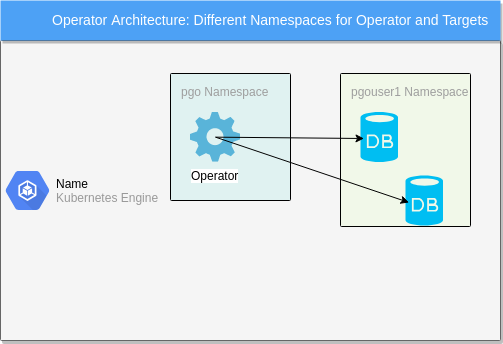Namespace Management
Operator Namespaces
The Operator itself knows which namespace it is running within by referencing the PGO_OPERATOR_NAMESPACE environment variable at startup time from within its Deployment definition.
The PGO_OPERATOR_NAMESPACE environment variable a user sets in their .bashrc file is used to determine what namespace the Operator is deployed into. The PGO_OPERATOR_NAMESPACE variable is referenced by the Operator during deployment.
The .bashrc NAMESPACE environment variable a user sets determines which namespaces the Operator will watch.
Namespace Watching
The Operator at startup time determines which namespaces it will service based on what it finds in the NAMESPACE environment variable that is passed into the Operator containers within the deployment.json file.
The NAMESPACE variable can hold different values which determine the namespaces which will be watched by the Operator.
The format of the NAMESPACE value is modeled after the following document:
OwnNamespace Example
Prior to version 4.0, the Operator was deployed into a single namespace and Postgres Clusters created by it were created in that same namespace.
To achieve that same deployment model you would use variable settings as follows:
export PGO_OPERATOR_NAMESPACE=pgo
export NAMESPACE=pgo

SingleNamespace Example
To have the Operator deployed into its own namespace but create Postgres Clusters into a different namespace the variables would be as follows:
export PGO_OPERATOR_NAMESPACE=pgo
export NAMESPACE=pgouser1

MultiNamespace Example
To have the Operator deployed into its own namespace but create Postgres Clusters into more than one namespace the variables would be as follows:
export PGO_OPERATOR_NAMESPACE=pgo
export NAMESPACE=pgouser1,pgouser2

RBAC
To support multiple namespace watching, each namespace that the PostgreSQL Operator watches requires its own copy of the following resources:
role/pgo-backrest-rolerole/pgo-rolerolebinding/pgo-backrest-role-bindingrolebinding/pgo-role-bindingsecret/pgo-backrest-repo-configserviceaccount/pgo-backrest
When you run the install-rbac.sh script, it iterates through the list of namespaces to be watched and creates these resources into each of those namespaces.
If you need to add a new namespace that the Operator will watch after an initial execution of install-rbac.sh, you will need to run the following for each new namespace:
create-target-rbac.sh YOURNEWNAMESPACE $PGO_OPERATOR_NAMESPACE
The example deployment creates the following RBAC structure on your Kubernetes system after running the install scripts:

pgo Clients and Namespaces
The pgo CLI now is required to identify which namespace it wants to use when issuing commands to the Operator.
Users of pgo can either create a PGO_NAMESPACE environment variable to set the namespace in a persistent manner or they can specify it on the pgo command line using the –namespace flag.
If a pgo request doe not contain a valid namespace the request will be rejected.